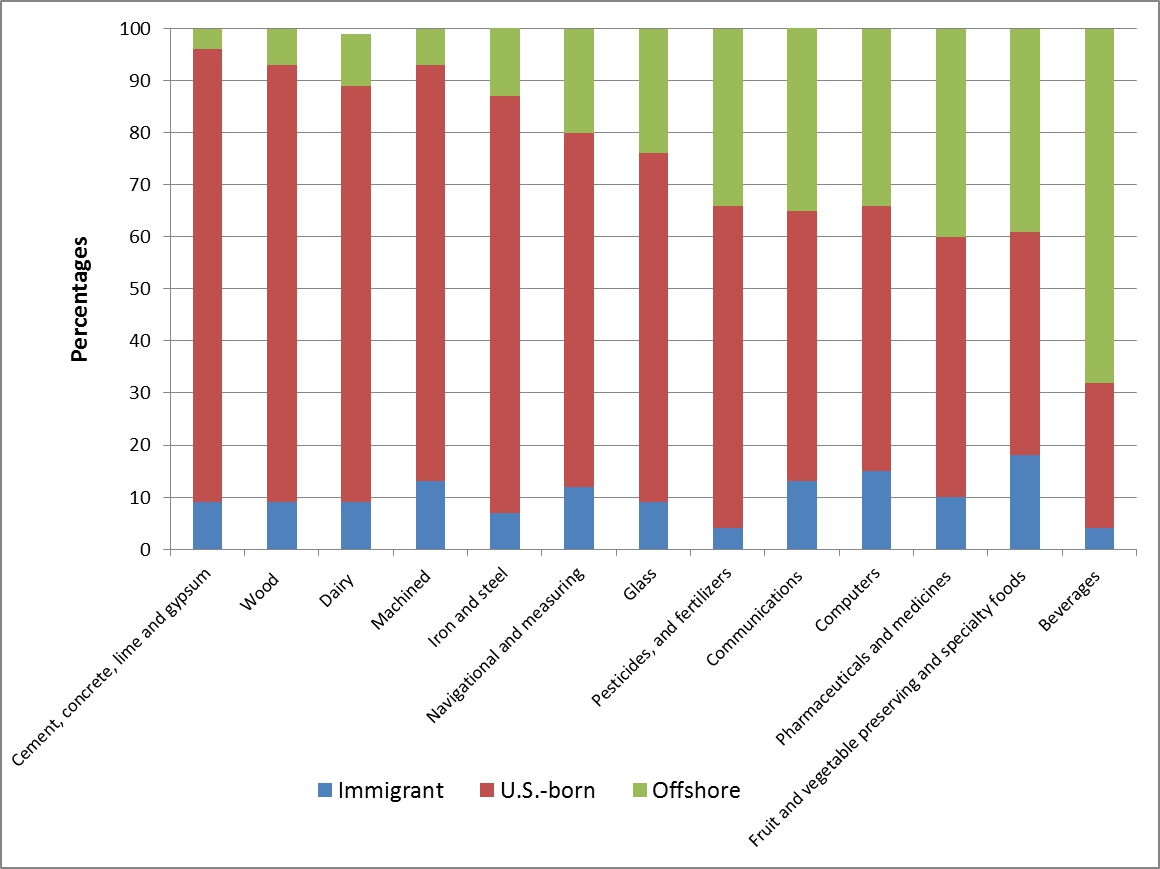

 The standard narrative on immigration and offshoring is that these practices uniformly harm American workers by providing cheap, alternative sources of labor. Using data taken from U.S. manufacturing industries between 2000 and 2007, Gianmarco Ottaviano, Giovanni Peri, and Greg Wright examine the impact of offshoring and immigration on native manufacturing workers. They find that, while offshoring production or hiring immigrants may directly displace American workers, the overall increase in production from this restructuring indirectly increases the demand for native workers, often in more complex roles.
The standard narrative on immigration and offshoring is that these practices uniformly harm American workers by providing cheap, alternative sources of labor. Using data taken from U.S. manufacturing industries between 2000 and 2007, Gianmarco Ottaviano, Giovanni Peri, and Greg Wright examine the impact of offshoring and immigration on native manufacturing workers. They find that, while offshoring production or hiring immigrants may directly displace American workers, the overall increase in production from this restructuring indirectly increases the demand for native workers, often in more complex roles.
The relocation of jobs abroad by multinationals and the increased labor market competition due to immigrant workers are often linked to the demise of many manufacturing jobs once held by American citizens. While it is certainly true that manufacturing production and employment, as a percentage of the total economy, have declined over recent decades in the U.S., measuring the impact of globalization on jobs is not that simple. We analyzed the employment patterns of 58 manufacturing industries from 2000 to 2007 and our results indicate that offshoring and immigration do not displace American manufacturing workers. While offshoring parts of the production process or hiring immigrants to perform them directly reduces the demand for native workers, the cost-savings of such restructuring of production increases the productivity and size of firms and improves their competitiveness. This process will indirectly increase the demand for native workers, if not exactly in the same tasks that were offshored or given to immigrant workers, then certainly in tasks that are complementary to them.

This raises the following questions. Within the manufacturing sector, how did the gains due to the decline in offshoring and immigration costs compare with the increased labor market competition for domestic workers? What kinds of occupations suffered most from the competition created by offshore and immigrant workers and what kinds of occupations benefited?
There are two key issues one has to deal with in order to tease out the specific impacts of offshoring and immigration on employment across manufacturing industries. First, the U.S. has been experiencing a persistent downward trend in manufacturing jobs due to structural changes that have little do to with globalization per se. Hence, the impacts of offshoring and immigration are identified using differences across manufacturing industries in their exposure to these two aspects of globalization and the subsequent employment changes. Figure 1 shows the exposure to offshore and immigrant labor across some representative industries.
Figure 1: Immigrant, Native and Offshore Workers as a Percentage of Total Sector Employment, 2007
The second issue is that a correlation between these intensities and the employment performance of native workers across industries does not necessarily reveal any causation from the former to the latter. For example, a booming industry may attract all types of workers, including immigrant and offshore workers, thereby generating a positive correlation between immigrant, offshore, and native employment. However, this boom-industry effect can be avoided by focusing instead on proxies for immigration and offshoring flows that are independent of industry-specific developments. In particular, using the fact that, in 2000, different industries used offshore labor from specific foreign countries while also employing immigrants from different foreign countries, we can use the subsequent uneven growth in offshoring and migration between those countries and the U.S. to obtain industry-specific variation. This is likely to be cost-driven, rather than driven by industry-specific demand factors.
Once these issues are dealt with, we find that increased offshoring reduces the share of both native and immigrant workers in total industry employment, while an increase in immigration reduces the share of offshore workers with no impact on the share of native workers. However, looking at employment levels (rather than shares), increased offshoring does not have an effect on the employment of natives in an industry whereas an increase in immigration has a small, positive impact on it. This is consistent with the existence of a positive productivity gain that generates an expansion of the overall employment of manufacturing industries that are most exposed to immigration and offshoring.

Finally, after matching different occupations with their content of “manual”, “communication” and “cognitive” skills, we can also assess the response in the complexity of the average task performed by native and immigrant workers on a manual, communication and cognitive scale. Our final finding is that increased offshoring pushes the average task performed by natives toward higher communication and cognitive content and the average task of immigrants toward more manual content. In contrast, an increase in the share of immigrants has little effect on the average task performed by natives.
Together these findings imply that immigrant workers do not compete much with natives, but rather compete for tasks that could be more easily performed by offshore workers. Since immigrants specialize in the least complex tasks, an increase in immigration is more likely to reduce the range of offshored tasks in an industry without affecting the employment level and type of tasks performed by natives. Offshore workers, on the other hand, specialize in tasks at an intermediate level of complexity and compete more directly with natives, thereby taking some of their jobs and pushing them toward more complex tasks. However, the positive productivity gains from offshoring indirectly eliminate this negative effect on native employment by stimulating the expansion of firms within an industry.
This article is based on the paper, “Immigration, Offshoring, and American Jobs” which was published in the American Economic Review in August 2013.
Please read our comments policy before commenting.
Note: This article gives the views of the authors, and not the position of USApp– American Politics and Policy, nor of the London School of Economics.
Shortened URL for this post: bit.ly/1dN9yIk
_________________________________
 Gianmarco I.P. Ottaviano – London School of Economics
Gianmarco I.P. Ottaviano – London School of Economics
Gianmarco I.P. Ottaviano is Professor of Economics at the London School of Economics and Political Science, associate of the Centre for Economic Performance London, research fellow of Centre for Economic Policy Research London and non-resident senior fellow of Bruegel Brussels. He is also editor of the Journal of Regional Science. His research interests span international competitiveness, migration, global cities, regional growth and regional decline.
 Greg Wright – University of Essex
Greg Wright – University of Essex
Greg Wright is a Lecturer in Economics at the University of Essex, with research interests in International Trade and Migration. His most recent research examines the labour market impact of offshoring and the rapid growth in services trade by U.K. firms.
 Giovanni Peri – University of California Davis
Giovanni Peri – University of California Davis
Giovanni Peri is Professor of Economics at the University of California, Davis and a Research Associate of the National Bureau of Economic Research in Cambridge, Massachusetts. He is also Editor of Regional Science and Urban Economics. His research focuses on the impact of international migrations on labor markets and productivity of the receiving countries and on the determinants of international migrations.




